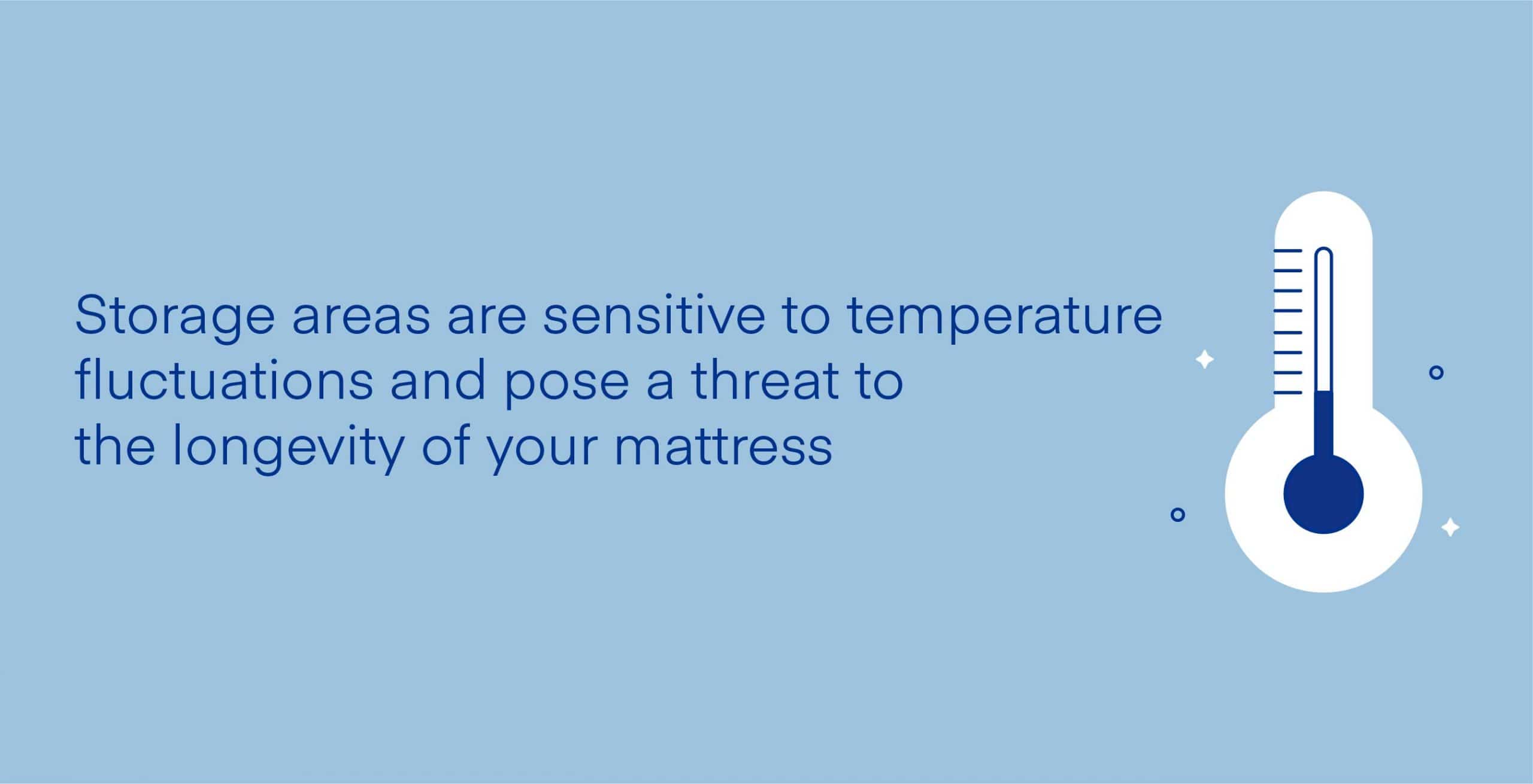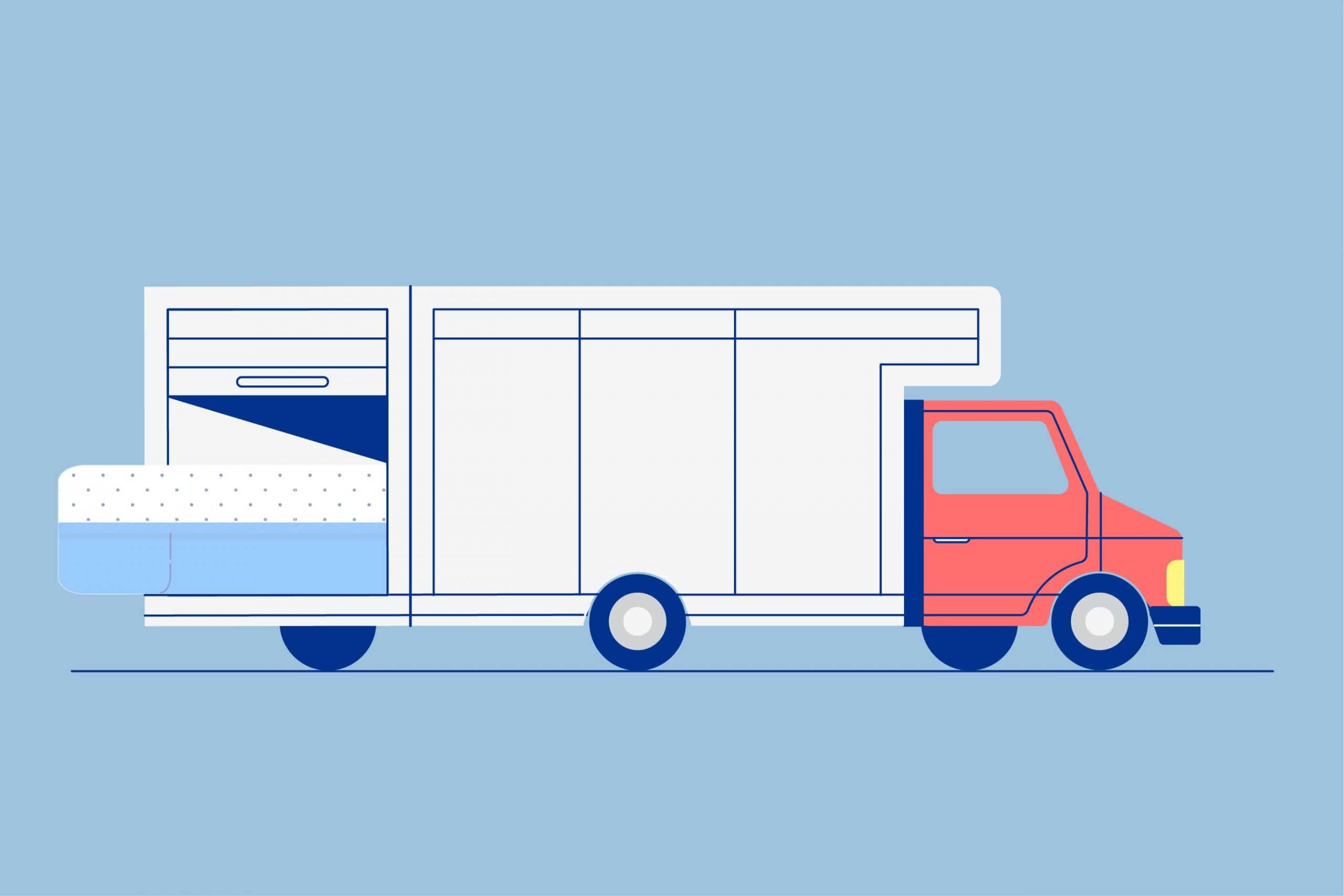Key Takeaways
- Clean Before Storage: Cleaning the mattress before storing it is crucial to prevent dirt, dust, dead skin, and sweat from accumulating. Vacuum the mattress thoroughly to remove these unwanted castoffs. Use baking soda or an appropriate upholstery cleaner to eliminate stains and odors. Ensure the mattress is completely dry before storage, especially for foam mattresses.
- Use Protective Measures: Wrap the mattress in a breathable plastic cover or a mattress storage bag to protect it from dust and dirt during transportation and storage. Avoid using thick, non-breathable materials like tarps, as they can trap moisture and lead to mold and mildew growth.
- Store Properly: Choose a climate-controlled storage unit, as temperature fluctuations can affect mattress longevity. Store the mattress flat on a clean, elevated surface to maintain its natural shape and prevent damage to foam or spring layers. Avoid placing household items on top of the mattress, as the continual pressure can lead to foam compression and damage.
Whether you’re repurposing a room, buying a new mattress, or have a child heading off to college, at some point you may find yourself storing a bed.
As tempting as it may be to simply lean the bed up against a wall in your basement or garage, this will significantly reduce its lifespan and rule out any chance of future use. Mattresses are expensive investments and require meticulous care to maintain, even when unused.
In this article, we will discuss how to properly store a mattress as well as unique factors to consider for different types of mattresses.
Best Practices for Storing Mattresses
Practicing preventative measures will ensure the quality of your mattress is maintained during its life in storage. These practices focus on thoroughly cleaning the mattress before storing it, using protective layers to preserve it, and optimizing the safety of its structural integrity.
Clean Your Mattress
Your bed sheets get a regular washing. However, when is the last time you sanitized your mattress?
Storing a dirty mattress will cause dirt, dust mites, dead skin, and sweat to accumulate, potentially forming a breeding ground for bacteria-causing mold.
Let’s take a look at the best way to sterilize your mattress before transferring it to storage.
- Vacuum the top, bottom, and sides of the mattress to remove any surface dirt, dust, or dead skin.
- Lightly coat the mattress with baking soda and let it sit for at least an hour. The baking soda will absorb any stains and eliminate odor. If you have a foam-free mattress, you may prefer an upholstery cleaner, but be sure to carefully follow the directions listed on the product.
- After an hour has passed, use your vacuum cleaner to remove the baking soda or upholstery cleaner.
- If you used an upholstery cleaner, do not move onto the next step until the mattress is completely dry.
Transport and Store Your Mattress In a Plastic Mattress Cover
Wrap your mattress in plastic and secure each side with packing tape to guard it against dust or dirt during transportation and storage. Be sure to opt for breathable plastic covers because thicker wraps, like a tarp, may trap moisture and lead to mold and mildew growth.
If wrapping your mattress in plastic and securing it shut with packing tape is too time-consuming for you, consider a mattress storage bag. Mattress storage bags are plastic encasements specifically designed to shelter beds during storage. They are also available in every mattress size, ensuring an easy application and proper fit.
Transport Your Mattress in a Covered Moving Truck
Avoid strapping your mattress to the top of a car. Forcefully bending your bed to sit on the top of a vehicle will compromise any internal springs. Use a covered moving truck instead, which will also protect your bed from inclement weather, like dust storms, rain, hail, or snow.
Use a Storage Unit With Climate Control
Never store your mattress in an attic, basement, garage, or shed. These storage areas are sensitive to temperature fluctuations and pose a serious threat to the longevity of your mattress. For example, the dampness of basement pipes could leave you with a water damaged mattress to dry or toss.

A temperature-controlled professional storage facility will prevent mold and mildew growth from high-humidity weather. If you cannot use a climate-controlled storage unit, placing a dehumidifier in the same space as your mattress will remove moisture from the air and prohibit mold and mildew development.
Store Your Mattress Flat
Maintaining the natural positioning of your mattress during long-term storage is critical to ensure it lasts a long time. Your storage facility may suggest standing the bed upright against a wall to save space. However, gravity will eventually force your mattress’s inner workings toward one side, causing latex or memory foam to hunch over and coil support cores to collapse from the pressure.
For safekeeping, lie a tarp on the ground of your storage space and place your mattress flat on top of it. If you are worried about placing your mattress directly on the floor, you can elevate it with wood pallets. If you cannot store your mattress flat, create an even surface from other pieces of furniture then lay your bed on top, ensuring it is not bent nor partial toward one side.
While storing your bed on top of other furniture is acceptable, avoid placing household items on the top of your mattress because its foam layers or springs will eventually fail from the continual pressure.
Other Factors to Consider
The above guidelines are effective for all types of mattresses. Still, different materials form various types of beds and call for distinct care.
Type of Mattress
In this section, we will go over extra precautions you should take when storing each type of mattress specifically.
Memory Foam Mattress
When it comes to memory foam mattresses, the cleaning process is one of the most important factors to consider before storing it.
As mentioned above, you should avoid using upholstery cleaners on foam mattresses because they are porous and do not easily absorb liquid-based products. These types of cleaners simply seep through the bed, so even if the surface feels dry, there may be moisture near the bottom. If the mattress is stored before completely drying, mold and mildew will form.
Hybrid Mattress
Like memory foam, hybrid mattresses typically have foam comfort layers just beneath the mattress cover, so steer clear of upholstery cleaners, but most importantly, avoid storing other household items on top of the mattress.
Hybrid mattresses consist of a pocketed coil support core with a memory or latex foam comfort layer. The coils and foam compress under pressure. However, the coils immediately spring back when we move. Additionally, frequently rotating the mattress prevents wear and tear from the repetitive pressure of our sleeping positions.
In storage, the items on top of the mattress are never removed nor are you able to frequently rotate the mattress, meaning nonstop pressure is applied to a single spot. Over time, the foam will break down and coils will collapse, resulting in lumpy soft spots.
Latex Mattress
Latex foam is made from the sap of rubber trees, making it denser and heavier than most other beds. Although durable, latex mattresses were not designed to sustain their own weight, so laying them in their intended position during storage is critical.
If you prop a latex mattress up on one side for a long period of time, excessive pressure will cause the upright half of the bed to topple toward the bottom. This will deteriorate the foam and your mattress will slump toward one side.
Innerspring Mattress
If you have an innerspring mattress, pay special attention to how you transport it.
The coils in an innerspring bed are not nearly as flexible as the layers of a memory or latex foam mattress. Slightly bending the mattress during transportation, could either force one or more coils through the mattress cover or weaken them, damaging the bed’s support system.
When transporting an innerspring mattress, there should be plenty of room for it to remain in its natural position or briefly stand on one side.
FAQs
How do you store box springs?
Store box springs and mattress foundations the same way you store your mattress. First vacuum the top, bottom, and sides of the bed base, then deep clean it using baking soda or upholstery cleaner. Like your mattress, guard the box springs with secured plastic and a covered vehicle during transportation.
Assuming you will use the same storage space as your mattress, ensure the area is climate controlled. Lastly, avoid exhausting the springs by placing the bed base flat rather than on one side. You may place your mattress on top of the box springs to save space.
How do you store a wooden bed frame?
Dust and clean your wooden bed frame before storing it. A vacuum cleaner, dry cloth, or duster can remove any surface dirt or dust while water with vinegar or an antibacterial cleaner, like dish soap, will sanitize it. Once you have cleaned the frame, allow it to dry, then treat it using a wood polish to lock in moisture. Locking in moisture will prevent your frame from drying out and cracking.
After sanitizing and polishing the wooden frame, disassemble it to simplify transportation and save storage space. Ease future reconstruction by placing any screws, bolts, nuts, or washers in a Ziploc bag then taping it to the headboard. Next, protect the wood by securely covering it with moving pads or old blankets. Avoid plastic wrap as it may create condensation from the locked-in moisture and lead to mold or mildew growth during storage. Lastly, opt for a climate control storage unit to prevent extreme heat from disintegrating the wood.
Can you roll up a mattress before storing it?
If your bed arrived compressed and rolled up in a small box, you may be asking yourself, “Why not ease transportation and maximize storage space by simply rerolling it?” Well, it’s not that simple.
Mattress companies have special machines to safely compress and roll bed in a box mattresses. If you compress and roll a mattress on your own, you can easily damage its layers and deplete it of support. Maintaining the natural positioning of your mattress during storage is frustrating, but will prevent wear and tear.
Can a mattress get bed bugs while in storage?
Storage companies take precautionary measures to ward off pests like bed bugs, but they are not always avoidable. Bed bugs can be carried in on other people’s furniture and sneak through the crevices of your storage unit’s door. Luckily, a plastic cover can protect your mattress from these pests. Guarantee the protection of your mattress by checking it for any small openings after transportation. If you find any openings, simply seal them with packing tape.
Is it okay to transport a mattress on its side?
Leaving a mattress on its side for weeks or months at a time will damage its structural integrity. However, simply transporting it from point A to point B for a few minutes, or even a couple of hours, will not cause harm. Just be sure to lay the bed flat as soon as you place it in storage.
Conclusion
If you are making the effort to store a bed, you or a family member probably plan on using it in the future. There are several steps you can take to ensure it remains in pristine condition until then, along with storing bedding and other associated items.
For instance, cleaning the bed before storage, guarding it with protective plastic, choosing a climate-controlled storage space, and storing it flat will keep even an old mattress in good shape. Paying close attention to the needs of your specific mattress type while carrying out these steps will properly preserve your bed, as well.
Although transporting and storing a mattress is no easy task, it will provide you with peace of mind and prove beneficial in the long run.
About the author
McKenzie Hyde is a Certified Sleep Science Coach and a full-time writer specializing in sleep health and the mattress industry. With a Master of Arts degree in literature and writing from Utah State University, McKenzie combines her passion for writing with her in-depth knowledge of sleep science. Her articles cover a wide range of topics, including best sleep practices for students, the consequences of sleep deprivation, and choosing the right mattress for back pain relief. McKenzie's dedication to delivering accurate and informative content makes her a valuable contributor to the field of sleep health.
View all posts





